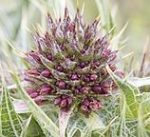 Native to the semi-desert areas of the eastern Mediterranean and the Middle-East this herbaceous perennial is a member of the aster family, Asteraceae, that also includes daisy, yarrow and lettuce. It has a thick, woody, verticle root and produces a rosette of leaves that gives rise to a low branching stem with 10 or more branches bearing pinnately dissected, toothed leaves measuring 2.7-12″ long and tipped with spines. The prominent mid- and side- veins are white sometimes tinged with purple and the leaf surface may be covered with spider-like hairs. The terminal compound flower heads are spiny, appear from late winter to mid spring, and consist of a single floret surrounded by its own involucre. The florets may be cream, white, yellow, greenish, purple, reddish or silvery. The fruit is an achene. As the plants mature they dry up, and from late spring to summer detach from the root and are rolled by the wind as a tumbleweed, dispersing their seeds over a wide area. Photo Credit Wikipedia
Native to the semi-desert areas of the eastern Mediterranean and the Middle-East this herbaceous perennial is a member of the aster family, Asteraceae, that also includes daisy, yarrow and lettuce. It has a thick, woody, verticle root and produces a rosette of leaves that gives rise to a low branching stem with 10 or more branches bearing pinnately dissected, toothed leaves measuring 2.7-12″ long and tipped with spines. The prominent mid- and side- veins are white sometimes tinged with purple and the leaf surface may be covered with spider-like hairs. The terminal compound flower heads are spiny, appear from late winter to mid spring, and consist of a single floret surrounded by its own involucre. The florets may be cream, white, yellow, greenish, purple, reddish or silvery. The fruit is an achene. As the plants mature they dry up, and from late spring to summer detach from the root and are rolled by the wind as a tumbleweed, dispersing their seeds over a wide area. Photo Credit Wikipedia
The Hebrew word gulgal is translated by a variety of words including dust/whirling dust, wheel, dried or dried thistles, rolling thing, and tumbleweed. Some authorities identify the plant as Palestinian tumbleweed but an alternative choice is thistle-like Gundelia tournefortii.
Psalms 83:13 (NIV) Asaph prays that God will scatter the enemies of Israel.
“Make them like tumbleweed, my God, like chaff before the wind.”
Isaiah 17:13 (NIV) The prophet tells the people that God will rebuke Israel’s enemies and chase them away.
“Although the peoples roar like the roar of surging waters, when he rebukes them they flee far away, driven before the wind like chaff on the hills, like tumbleweed before a gale.”
Tumble thistle likes full sun and light, medium moist, well-drained soil in USDA Hardiness Zones 7 and warmer. Propagation is by seed. All parts of the plants are edible and are used as food while while the milky latex is used to make chewing gum. In addition, the plants have significant medicinal value and can be used to treat a variety of diseases. Recently Gundelia has become of interest because its pollen was discovered on the Shroud of Turin and some authorities have suggested that this indicates that the crown of thorns was made of Gundelia. This theory, however, is disputed.
The genus name, Gundelia, honors Andreas von Gundelsheimer (1668–1715), a German botanist who accompanied Tournefort on his collecting trip to the Levant. The specific epithet, tournefortii, honors Joseph Pitton de Tournefort, a French botanist, who first collected, described, and illustrated the plant in the Levant.